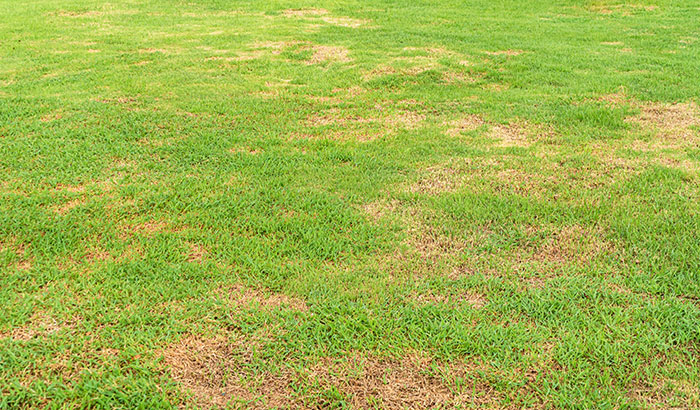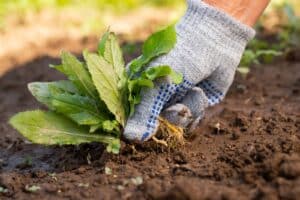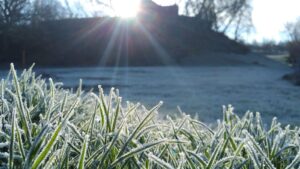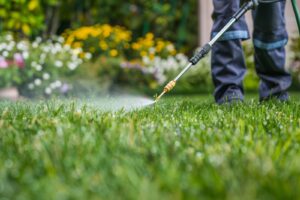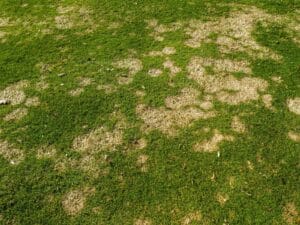Just the thought of lawn disease and a dead lawn can send shivers down the spines of those dedicated to keeping their lawns green.
Picture this: a once-lush expanse of greenery, meticulously cared for, now marred by unsightly dead grass patches. As a lawn enthusiast, you understand just how hard it is to maintain a picture-perfect lawn, and lawn disease can make that task much harder.
Your lawn serves as a backdrop for countless memories, a place for kids to frolic and play, and a sanctuary for relaxation and recreation. All that can go away if your grass won’t grow, and soon you’re stuck with a dead lawn.
But what exactly is lawn disease, and what causes it? Is there anything you can do to avoid it? We’ll answer all these questions and more in this blog.
Together, we’ll unravel the secrets of lawn diseases and arm you with the knowledge needed to restore your yard to its former glory.
Let’s get started!
Understanding Lawn Disease
Lawn diseases are complex and intricate issues that can take a toll on the health and appearance of your beloved turf; often, patches of your grass won’t grow if infected. To effectively combat these challenges, it’s essential to develop a solid understanding of the basics of lawn diseases.
At their core, lawn diseases are often caused by pathogens such as fungi, bacteria, or viruses that infiltrate the grass plants, disrupting their normal growth and vitality. These pathogens can be introduced to your lawn through various means, including contaminated soil, infected plant debris, or by wind or waterborne spores.
The conditions that promote the development and spread of lawn diseases are often influenced by environmental factors. Excessive moisture or humidity, poor air circulation, and inadequate sunlight can create an environment ripe for disease development.
Additionally, specific grass varieties may be more susceptible to certain diseases than others, emphasizing the importance of selecting disease-resistant grass types for your region.
Identifying lawn diseases can be challenging, as different diseases exhibit various symptoms. Common signs include discoloration, dead grass patches, thinning turf, irregular patterns or shapes, and the presence of fungal growth or lesions. Early detection is crucial, as prompt action can prevent further damage and aid in effective treatment.
Proper lawn maintenance practices play a significant role in preventing and mitigating the impact of lawn diseases. Consistent and appropriate watering techniques, balanced fertilization, regular mowing with correct heights, and adequate soil management are vital components of a proactive lawn care routine.
By understanding the fundamental principles of lawn diseases and their contributing factors, you’ll be better equipped to identify potential problems, take preventative measures, and implement effective solutions, like contacting professional lawn care professionals.
In the following sections, we’ll delve deeper into specific types of lawn diseases in Utah, providing you with comprehensive insights and strategies to tackle them head-on.
Common Types of Lawn Diseases in Utah
All states are susceptible to lawn disease, and Utah is no exception. Here are some of Utah’s most common lawn diseases, what causes them, how to avoid them, and how to treat them.
Necrotic Ring Spot
- What is it: Necrotic ring spot is a common lawn disease that can wreak havoc on the health and appearance of your grass. It is characterized by circular or ring-shaped patches of dead or dying turf, often with a patch of green grass in the center of the ring.
- Causes: Necrotic ring spot is primarily caused by a group of soil-borne fungi that thrive in warm, humid conditions. The disease typically develops from mid-May through mid-September while soil temperature is between 65 degrees and 80 degrees Fahrenheit, and the disease survives on dead bluegrass roots.
- Treatment: Doing things that will reduce the stress on your grass will help prevent and suppress necrotic ring disease. Make sure you follow proper watering practices for your area and use fertilizer as needed.
Ascochyta Leaf Blight
- What is it: Ascochyta leaf blight is a common lawn disease that affects grasses, including Kentucky bluegrass and tall fescue. This fungal disease can cause significant damage to the appearance and health of your lawn if left unchecked.
Ascochyta typically manifests as irregularly shaped, blighted, straw-colored grass patches with tan or reddish-brown blade lesions. The disease often spreads rapidly, especially during periods of warm, humid weather.
- Causes: The weather is usually to blame for Ascochyta. It often gains a foothold in lawns that are stressed or weakened by factors such as improper irrigation, excessive thatch accumulation, inadequate fertilization, or frequent close mowing.
Additionally, the disease can spread through infected grass clippings, tools, or equipment used for lawn maintenance; lawnmowers can spread the disease throughout the lawn.
- Treatment: This disease will most likely go away after a few weeks, but it helps to practice proper mowing and watering techniques to help prevent the spread. If you want additional help, seeking the help of a lawn care professional will be beneficial.
Gray Snow Mold
- What is it: Gray Snow Mold is a cold-season lawn disease that commonly affects grasses in regions with snowy winters. It can cause significant damage to lawns, particularly when the snow cover persists for extended periods.
It appears as circular or irregular patches of matted, grayish, or straw-colored grass on the lawn.
- Causes: Gray Snow Mold is caused by certain species of the fungus Typhula, which thrives in cool, moist environments, such as snow-covered or wet lawns. The disease typically becomes active during late winter or early spring when snow begins to melt.
Prolonged snow cover periods and cool temperatures create the ideal conditions for Gray Snow Mold development.
- Treatment: In most cases, Gray Snow Mold does not require specific treatment, as the disease tends to resolve on its own as the lawn begins to actively grow in spring. You should break up snow piles and rake up leaves to prevent it.
However, to aid recovery, lightly raking the affected areas to promote air circulation and remove the fungal mycelium can be beneficial. If the damage persists, overseeding or reseeding the affected areas in early spring may be necessary to encourage new grass growth.
Pink Snow Mold
- What is it: Pink snow mold is another cold-season lawn disease that commonly affects grasses in regions with snowy winters. It can cause damage to lawns when conditions are cool and moist, typically appearing in late winter or early spring.
Like grey snow mold, pink snow mold presents as circular or irregular patches of matted, straw-colored grass on the lawn. These dead grass patches may have a pink or reddish hue, particularly at the outer edges.
- Causes: Pink snow mold can survive in higher temperatures than grey snow mold, meaning that wet piles of grass on your lawn can be enough to encourage its growth.
- Treatment: The same treatment steps for gray snow mold apply to pink snow mold.
Other Diseases
It’s important to recognize that various other diseases can impact your lawn. These diseases often exhibit similar symptoms, making it challenging for homeowners to accurately pinpoint the specific issue affecting their turf.
Given the complexities involved in diagnosing and treating lawn diseases, it is highly advisable to seek the expertise of a professional lawn care service. These experienced professionals possess the knowledge and skills to assess the condition of your lawn, accurately identify the underlying disease(s), and provide tailored treatment solutions.
Lawn care professionals are well-versed in recognizing subtle differences in symptoms, such as variations in lesion appearance, coloration, or patterns. This keen eye for detail enables them to make precise disease identifications, which in turn informs their recommended treatment strategies.
They have access to specialized diagnostic tools and techniques that aid in accurate disease assessment, ensuring the most effective course of action for your lawn.
By consulting a lawn care professional, you can benefit from their comprehensive understanding of disease management. They can recommend appropriate fungicides, advise on optimal application methods and timing, and provide valuable insights into cultural practices like watering, mowing, and fertilization that help prevent future disease outbreaks.
How to Prevent Lawn Disease
Prevention is always better than cure, and this holds true when it comes to lawn diseases. By implementing proper lawn care practices, you can create an environment that discourages the development and spread of diseases, ensuring your turf’s long-term health and vitality.
Here are some best practices for preventing lawn disease:
Proper Mowing Techniques:
- Set your mower blade at the recommended height for your grass type to avoid scalping or overgrowth.
- Regularly sharpen the mower blade to ensure clean cuts and minimize stress on the grass.
- Never remove more than one-third of the grass blade length in a single mowing session.
Adequate Watering:
- Water deeply and infrequently to encourage deep root growth.
- Water early in the morning to allow the grass blades to dry before evening, reducing the risk of disease.
- Avoid frequent light watering, which promotes shallow root growth and increases disease susceptibility.
Proper Fertilization:
- Test your soil to determine its nutrient needs and apply fertilizer accordingly.
- Follow recommended fertilizer application rates and timings to promote healthy growth.
Thatch Management:
- Regularly dethatch your lawn to remove excessive thatch buildup, which can harbor disease-causing organisms.
- Aerate the soil to improve air circulation and water absorption, reducing the likelihood of disease development.
Proper Weed Control:
- Keep your lawn free from weeds, as they can compete with the grass for nutrients and create favorable conditions for diseases.
- Use appropriate weed control methods, such as targeted herbicides or manual removal, to maintain healthy turf.
Regular Soil Testing:
- Conduct periodic soil tests to assess nutrient levels and pH balance.
- Adjust soil pH and supplement nutrients as needed to create optimal growing conditions for your grass.
Timely Disease Prevention:
- Apply preventive fungicides as recommended by a professional, particularly if your lawn has a history of disease outbreaks.
- Monitor your lawn regularly for signs of disease, and take prompt action at the first signs of trouble.
By following these best practices for lawn care, you can establish a robust defense against lawn diseases. Implementing these preventive measures will not only help keep diseases at bay but also promote your lawn’s overall health and beauty.
Don’t Let Lawn Diseases Ruin Your Landscape; Let Summit Lawn and Pest Control Help
Grass won’t grow? We can help.
When it comes to maintaining a healthy and disease-free lawn, the expertise of a professional can make all the difference. At Summit Lawn and Pest Control, we are dedicated to helping you achieve the lush, vibrant lawn you’ve always desired. Our team of experienced professionals is equipped with the knowledge, tools, and solutions to prevent and treat lawn diseases effectively.
Don’t let lawn diseases compromise the beauty and health of your landscape. Contact Summit Lawn and Pest Control today by calling us at 801-473-9926 for a personalized consultation, and let us provide you with tailored solutions to help you avoid a dead lawn.
Experience the peace of mind of entrusting your lawn care to experts committed to delivering exceptional results.


